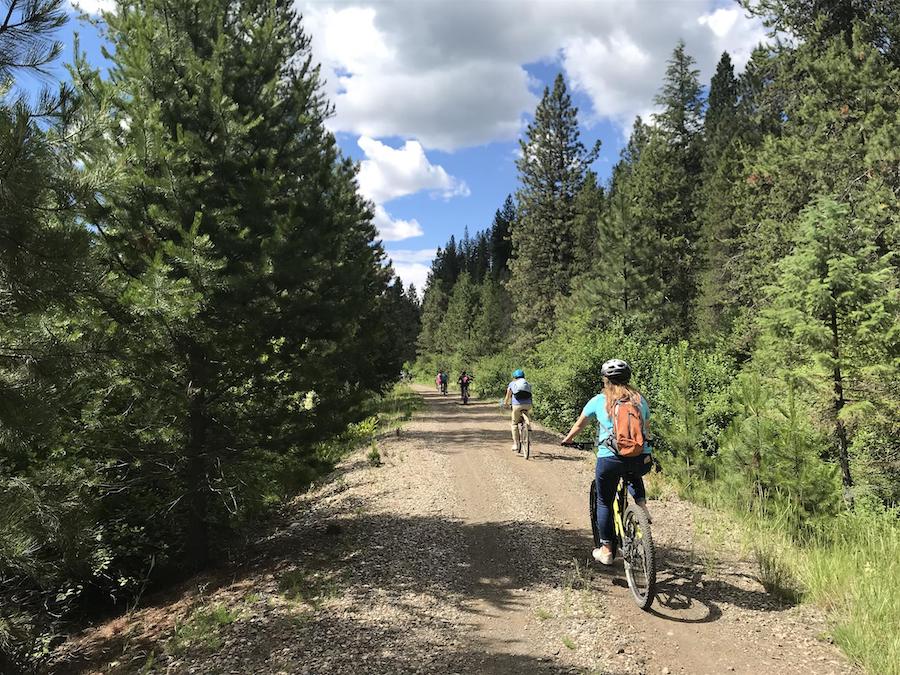Idaho’s Weiser River National Recreation Trail

Trail of the Month: June 2022
“Those people who started the trail worked hard; they put a lot of love and sweat into it.”
—Mike Beavers of Wilder, Idaho
When someone says “Idaho,” most people think of potatoes, but the Weiser River National Recreation Trail demonstrates there is so much more to the landscape and the people. Traveling 84 miles—from forested terrain through canyons and onto the high prairie in the west-central part of the state—there is an ever-changing beauty that evokes an appreciation of the region and the forward-thinking individuals who sought to preserve the corridor.

Most trail users begin on its north end, just a few miles northwest of New Meadows to take advantage of the slight downhill slope. Starting at this point, conifer forests create an evergreen corridor as the trail travels along the Weiser River. Throughout its length, 62 trestles cross water and coulees. Farther south, the landscape transitions to sagebrush and yucca in this high steppe ecosystem. Besides spectacular scenery, black bears are often spotted, along with deer, elk and plenty of cows.
Roughly 20 miles south of its northern terminus, the town of Council (home to the World Famous Porcupine Races) has ample amenities, and at roughly the half-way point near Cambridge, Mundo Hot Springs is a popular stop to soak away the aches and pains of a long ride or hike. Ten miles beyond Cambridge at Midvale, be ready for 20 miles of remote travel with no cell service, but it’s another chance to ride through a beautiful canyon. Lush fields of alfalfa, onion and yellow-flowered canola welcome travelers approaching trail’s end in Weiser, about 75 miles northwest of Boise.
“It provides benefits for all the communities,” said Pat Trainor, president of the Friends of the Weiser River Trail. He noted that the Cambridge cross-county team uses their section for practice, Weiser has their firefighters test and train on the trail, and Midvale decorates part of it with lighted hoops arching over the trail at Christmas. “And every town has their seniors that walk the trail every day.”
From Rails to Trails

The corridor’s beginning dates back to 1899 with the creation of the Pacific & Idaho Northern Railway, known as the P&IN, which grew to the nearly 90-mile span between New Meadows and Weiser by 1911. It served as an important farm-to-table conveyance for decades and encouraged growth in the region as vibrant communities sprung up along its route. After its sale to the Oregon Short Line of the Union Pacific in 1936, the line primarily hauled timber and livestock. Just shy of four decades later, the Union Pacific stopped using the historical P&IN route and removed the rails the following year.
Recognizing a once-in-a-lifetime opportunity, an intrepid group of community-minded individuals formed a nonprofit organization: the Friends of the Weiser River Trail. The group, which officially incorporated in July 1996, focused on preserving the integrity of this historical railroad corridor for public use and protecting the riparian and other natural habitats for future generations.
After spending the first part of 1996 outlining a plan and convincing local and state officials that this was a benefit for the region, as well as receiving support and guidance from Rails-to-Trails Conservancy, Chris Malloy, Barbara Barber, Dick Pugh, Shirley Atteberry and Lane Williams took the reins of the daunting project. With 77 members, they directed the enthusiasm and skills to further the trail effort.
Early on, they hit a major challenge with a devasting flood on New Year’s Day 1997, which damaged a dozen sections of the trail. With no money yet and concern that local municipalities would permanently close sections where trestles and track beds had washed away, it was a sheer force of will within their membership to raise the money and rally the talent to repair the trail.
A New Direction

In August 1997, Union Pacific deeded the route to the group under the 1983 Railbanking Act, an amendment within the National Trails System Act, and the path began a new journey, albeit a bumpy one at the start. John Atteberry, an early member of the organization, said in his account of the history of the group, “[They were] letting the world know that they owned a trail and were here to stay.”
The premise of railbanking allows a qualified organization to convert a disused rail corridor into a trail with the understanding that the railroad could call it back into service at a later date. For many rail-trails, a governmental agency manages the railbanked corridor but, in this case, the Friends of the Weiser River Trail does. While railbanking the corridor would benefit the communities along the route, not everyone saw it that way at first.
It boils down to who owns the property. If a rail line is abandoned, it reverts to neighboring landowners. This isn’t the case with railbanking, which preserves the corridor intact for public use. “The ranchers thought they would get it,” explained Trainor, and decades of legal wranglings and disputes followed.
Trainor said after 25 years, attitudes are shifting. “It takes a generational change,” he said. “They can see it from a different perspective.” Now children and grandchildren of the original opposition are utilizing the trail and recognizing its benefits to the community.
Trainor strives to continue this positive relationship. “We should be good neighbors and maintain fences,” said Trainor. They also install cattle control gates and grant concessions to ranchers who need to use motorized equipment for necessary tasks even though the trail has nonmotorized status, as a way to work together.
Related: Learn more about railbanking in our Trail-Building Toolbox
A Path for All

The path that once hauled people and freight is now the longest rail-trail in Idaho, as well as part of the National Recreation Trails system, offering opportunities for pedestrians, bicyclists (including Class 1 and Class 2 e-bike users), equestrians and others.
With over a dozen access points along the route, the Weiser River Trail is ideally suited for day trips, as well as extended excursions. While spring and fall are the favorite seasons for most recreationists because the basalt canyon walls capture the heat during the summer, there’s a growing interest in cold-weather activities. Dog teams use the route for training, plus the trail beckons cross-country skiers and wintertime walkers. Trainor mentioned that one of their projects is to plow certain sections to facilitate additional winter use.
For those who don’t wish to travel the trail solo, the Friends of the Weiser River Trail organizes several fully supported events, including bicycle outings in June and October that participants to experience the trail during these uniquely beautiful seasons. And multiple other groups, ranging from local clubs to Scouting troops, plan outings and extended events.
One of the highlights of the year is the annual Wagon Train over Memorial Day weekend. Pam Haynes, board member and wagon train organizer, explained that, over 20 years ago, Dan Dickerson, Terry Bonner and Joe Stoneman put their heads together and decided a wagon train would draw positive attention to the trail. To this day, Stoneman’s sons, Alan and Lynn, are involved.
During those early days, Haynes said, “The trestles weren’t even planked.” Not deterring this hardy crew, she continued, “They actually towed along a port-a-potty and brought plywood to put on the trestles [so the teams could cross safely]. As the trail improved, the event grew.”
Beginning in Weiser and traveling to Council, the four-day, fully supported event brings together people from several neighboring states. Besides the wagon teams, individuals on horseback are welcome, as well as bicyclists. The Friends of the Weiser River Trail haul the camping gear and work the cook tent, along with bringing hay for the horses to ensure they eat well, too, while making it easier for riders and drivers.
More than a simple outing, the Wagon Train is a reunion. “We’ve been doing it since 2011,” said Mike Beavers of Wilder, Idaho. The first year he rode his horse with a friend, but he has since started driving a two-seat surrey with his wife Jeannie led by their horse Dollar.
This was also a special year for future generations. “This is the first time my daughter and grandson joined us,” said Beavers, who noted that his 8-year-old grandson, Robbie, learned to drive horses during the weekend. “I think they’ll be back next year.”
The journey consists of three nights of camping: a primitive camp in the canyon for the first night, a park in Midvale (which offers welcomed showers) for the second night, and a final night in Goodrich at an old school that last held class in 1955. Beavers said one of the highlights of this year was listening to the chukars (a type of game bird) and coyotes, as well as his grandson counting at least 30 rooster pheasant calls along the way. Every Wagon Train weekend is a time for camaraderie and celebration.
“Those people who started the trail worked hard; they put a lot of love and sweat into it,” said Beavers, who lends a hand whenever he can to do improvements such as installing mounting blocks for equestrians near gates.
With slow and steady progress, and now boasting over 650 members, the Friends of the Weiser River Trail continue to build upon their accomplishments by upgrading amenities, sponsoring events and making the trail more user friendly. Trainor said their reward is “miles on the trail” for everyone to enjoy.
Related: Top 10 Trails in Idaho

Donate
Everyone deserves access to safe ways to walk, bike, and be active outdoors.
